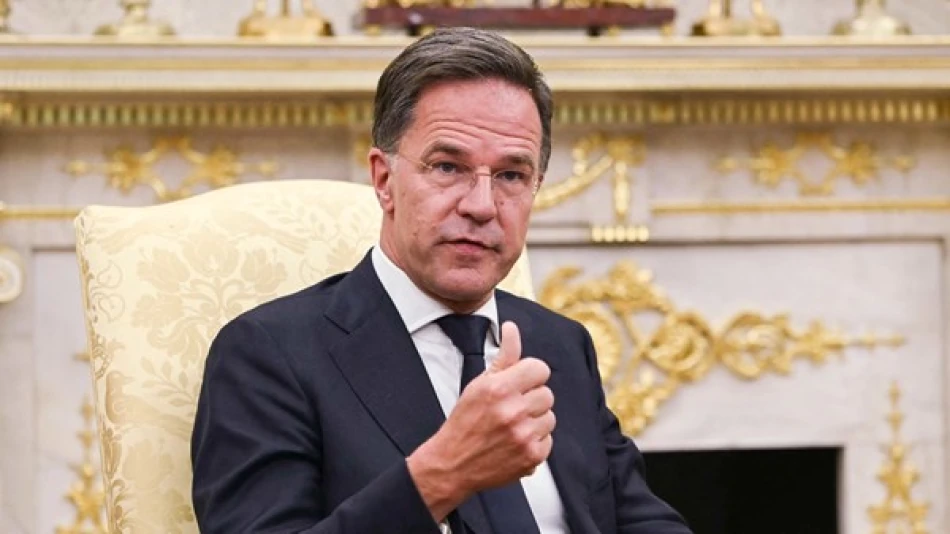
NATO: Ukraine to Receive Massive Weapons Stockpile to Bolster Defense
NATO Chief Promises "Massive" Weapons Surge for Ukraine as Trump Signals Policy Shift
NATO Secretary-General Mark Rutte announced Monday that Ukraine will receive "massive" quantities of military equipment worth billions of dollars, following high-level discussions with President Donald Trump at the White House. The commitment comes just days after Washington imposed a partial suspension on previously promised weapons shipments, signaling a potential recalibration of U.S. military aid strategy under the new administration.
Multi-Billion Dollar Military Package Takes Shape
Speaking to reporters after his meeting with Trump, Rutte outlined the scope of the planned military assistance, which will include advanced air defense systems, missiles, and ammunition. The NATO chief emphasized that the weapons deliveries will proceed under a formal agreement between the alliance and the United States.
Trump confirmed the substantial financial commitment, stating that the military supplies—including sophisticated Patriot missile defense systems—will be valued at "billions of dollars." This represents one of the largest coordinated NATO-U.S. weapons packages since the conflict began in February 2022.
Strategic Timing Amid Policy Uncertainty
The announcement carries particular significance given the Trump administration's previous skepticism toward extensive military aid to Ukraine. During his first presidency, Trump frequently criticized NATO allies for insufficient defense spending and questioned America's role in European security arrangements.
Ukrainian President Volodymyr Zelenskyy had already indicated earlier this week that his government received assurances of new weapons shipments from both American and European allies, suggesting coordinated diplomatic efforts to secure continued military support.
The Patriot System Factor
The inclusion of Patriot missile defense systems represents a crucial capability upgrade for Ukraine's air defenses. These systems, manufactured by Raytheon, cost approximately $1 billion per battery and have proven effective against Russian missile and drone attacks on Ukrainian infrastructure.
Market and Defense Industry Implications
Defense contractors are likely to benefit significantly from the expanded weapons commitments. Companies like Raytheon Technologies, Lockheed Martin, and General Dynamics have already seen increased orders due to Ukraine-related military aid, and this latest package should sustain production momentum.
The coordinated NATO-U.S. approach also suggests a more systematic, long-term procurement strategy rather than ad-hoc emergency shipments. This could provide greater revenue predictability for defense manufacturers and potentially drive innovation in key weapons categories.
Navigating the Aid Suspension Paradox
The timing creates an apparent contradiction: while promising massive new weapons deliveries, the Trump administration simultaneously imposed a partial suspension on previously committed shipments last week. This suggests the new administration may be restructuring aid mechanisms rather than reducing overall support levels.
Such an approach could reflect Trump's preference for multilateral burden-sharing, where NATO allies contribute more substantially to Ukraine's defense while the U.S. maintains strategic oversight. This would align with his longstanding criticism of European defense spending levels.
Broader Strategic Calculations
The weapons commitment occurs as Ukraine faces intensified Russian attacks on its energy infrastructure and civilian targets. Military analysts suggest that robust air defense capabilities remain Ukraine's most critical need, making the Patriot systems particularly valuable.
From a geopolitical perspective, the coordinated NATO-U.S. announcement sends a clear signal to Moscow that Western military support will continue despite changes in American leadership. This could influence Russian strategic calculations about the conflict's duration and potential negotiation timelines.
The success of this expanded weapons program will likely depend on NATO allies' ability to maintain production capacity and coordinate logistics across multiple countries—a complex undertaking that will test the alliance's operational capabilities beyond traditional peacetime cooperation.
Most Viewed News

 Layla Al Mansoori
Layla Al Mansoori






